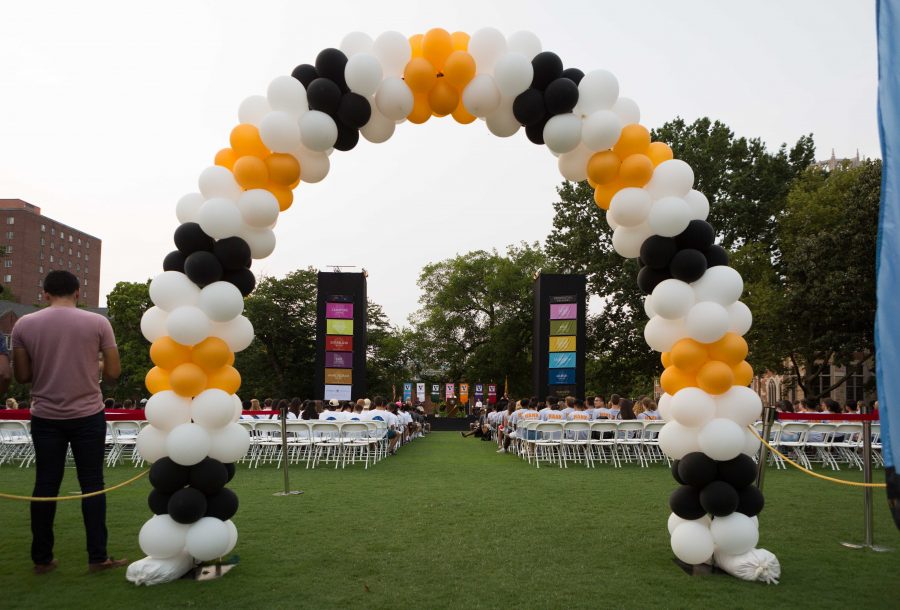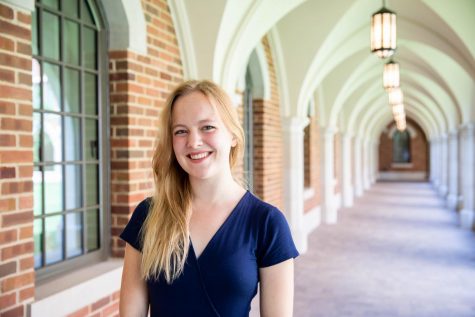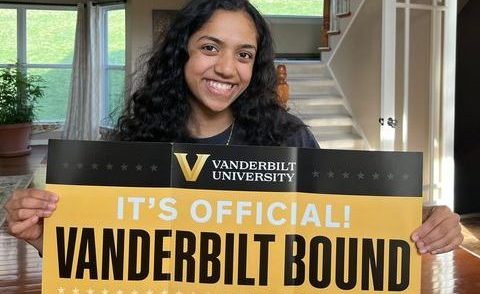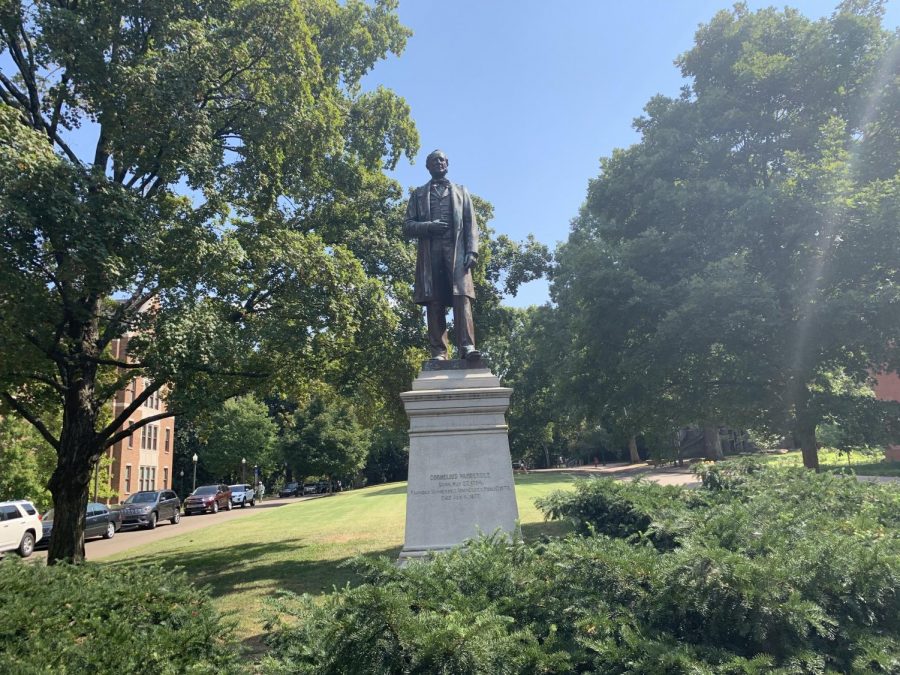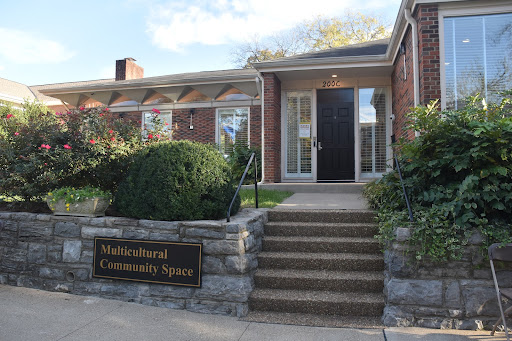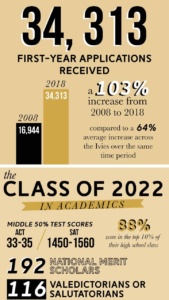 For the first time in Vanderbilt’s history, the acceptance rate has dropped below 10 percent, reaching 9.6 percent for the Class of 2022. The university also saw its largest applicant pool ever, with 34,313 first year applications for the 2022 class. The growth of Vanderbilt’s application pool has been significantly greater than that of peer institutions over the last 10 years, with Vanderbilt seeing a 103 percent increase, compared to a 64 percent growth in applications at Ivy League institutions.
For the first time in Vanderbilt’s history, the acceptance rate has dropped below 10 percent, reaching 9.6 percent for the Class of 2022. The university also saw its largest applicant pool ever, with 34,313 first year applications for the 2022 class. The growth of Vanderbilt’s application pool has been significantly greater than that of peer institutions over the last 10 years, with Vanderbilt seeing a 103 percent increase, compared to a 64 percent growth in applications at Ivy League institutions.
“[The 9.6 percent acceptance rate] will probably put us, when the stats come out next year, when we have them from all the other schools, within the top nine to 11 most selective schools in the country, including the Ivies,” Doug Christiansen, Vice Provost for University Enrollment Affairs and Dean of Admissions and Financial Aid said.
Vanderbilt’s Class of 2022 continues the tradition of high accomplishment set by previous classes. The majority of the class ranked in the top 10 percent of their high schools, and the middle fifty percent of students scored in the 98th percentile in standardized test scores. The percentage of the class made up of minority students decreased compared to last year, from 45 percent to 43.2 percent, while the percentage of Pell Grant recipients remained at 15 percent.
According to Christiansen, the introduction of the Commons, Opportunity Vanderbilt, the residential colleges and a pipeline recruitment strategy have all had an effect on increasing the university’s applicant pool. Due in part to these significant changes, Vanderbilt’s peer group has come to include top ranked institutions like Harvard, Princeton and Yale.
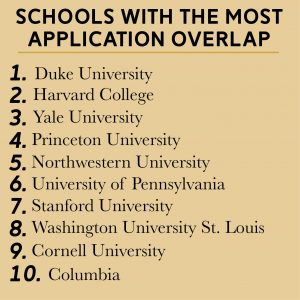 “Instead of being the admissions office that reviews applications, which we do, we’ve been proactively going, much more, and recruiting younger students because of the rarified territory we’re in,” Christiansen said. “Of the students admitted here now, likely they’ve been admitted to Harvard, Yale and Princeton, if they applied. So we just want to start as early getting Vanderbilt in their mind, so if they are admitted to us and another school, and they might choose the other school, they know they’re giving something up here.”
“Instead of being the admissions office that reviews applications, which we do, we’ve been proactively going, much more, and recruiting younger students because of the rarified territory we’re in,” Christiansen said. “Of the students admitted here now, likely they’ve been admitted to Harvard, Yale and Princeton, if they applied. So we just want to start as early getting Vanderbilt in their mind, so if they are admitted to us and another school, and they might choose the other school, they know they’re giving something up here.”
The pipeline recruitment strategy starts early, with the university sending communications to high school freshman to encourage them to begin the college planning process. Vanderbilt then reaches out to families during the students’ sophomore year to provide information about Opportunity Vanderbilt and the financial aspect of the college process. By the student’s junior and senior year, the university’s hope is that they have built up enough of a relationship with those students to encourage application, and eventually matriculation, to Vanderbilt.
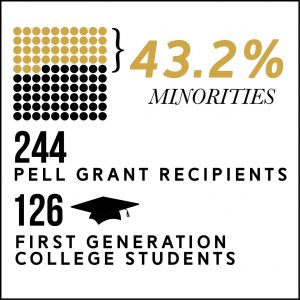 In addition, Vanderbilt’s admissions officer make a concerted effort to recruit applicants from schools that would not be considered part of the traditional Vanderbilt recruiting pool, including those in low-income areas, with high populations of students receiving free and reduced lunch or with high minority student enrollment. For every day that an admissions officer spends recruiting in a city, they are required to visit at least one of these schools in order to broaden Vanderbilt’s applicant pool.
In addition, Vanderbilt’s admissions officer make a concerted effort to recruit applicants from schools that would not be considered part of the traditional Vanderbilt recruiting pool, including those in low-income areas, with high populations of students receiving free and reduced lunch or with high minority student enrollment. For every day that an admissions officer spends recruiting in a city, they are required to visit at least one of these schools in order to broaden Vanderbilt’s applicant pool.
“Once we’ve hit them, we want to stay with them for three years, minimally, because we want to make sure that it’s not in and out, because you’re not building any relationship, there’s not a brand identity,” Christiansen said. “If they can see that we’re coming back and serious, it just builds a better relationship.”
Vanderbilt’s concerted recruitment efforts have been behind the growth in not only the diversity and size of the applicant pool, but the universities geographic diversity as well. While Vanderbilt’s brand is still most recognizable in the surrounding southeastern states, Christiansen said the fastest growing region is the West, which saw a 1.3 percent increase compared to the class of 2021.
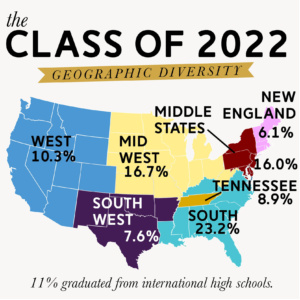
Now, the admissions office is turning its attention to the next class of Vanderbilt students. Over the course of eight weeks, from early September to early November, recruitment officers will accumulate 141 weeks of travel, visiting 48 states and 34 countries. These officers, who also serve as application readers, will attempt to continue widening Vanderbilt’s applicant pool.
“It’s a sense of the philosophy of building a pipeline that is inclusive and broad, not narrow,” Christiansen said. “And I suspect if you look at Vanderbilt and our history, you can look at the data I’m sure, 20 years ago this philosophy was not happening. Vanderbilt has changed so much.”
Graphics by Christia Victoriano

